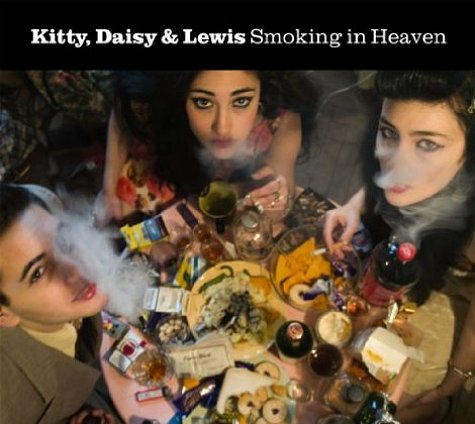Videos by American Songwriter
Kitty, Daisy & Lewis
Smoking in Heaven
(Verve)
[Rating: 3.5 stars]
Lewis Durham of the young trio Kitty, Daisy & Lewis, has created a time machine in the front room of the band’s North London home. It’s not of the H.G. Wells variety, but rather, a carefully cultivated collection of studio equipment from America’s lost history of recording, consisting of tape machines and vintage ribbon mics from more than six decades ago.
The unique sound of the multi-instrumentalist siblings is heavily influenced by American rockabilly, jazz, blues, R&B, country and Jamaican ska of the 40s, 50s and 60s. Their music isn’t a retro fad dreamt up by a marketing team to create the next big thing; it comes from a place of genuine appreciation.
In 2007, Kitty, Daisy & Lewis self-released The A – Z of Kitty, Daisy & Lewis. The music was recorded on their home studio analog equipment, just as on their first official release, the self-titled album and first on UK label Sunday Best. These albums are filled mostly of covers of songs that their father Graeme played for them during their childhood, helping to foster a love for music from another era. The band’s singular sound, which is impossible to categorize, is part of their musical DNA.
Their newest album, Smoking in Heaven, finds the brother and sisters refining their sound that affirms a past they only heard of, and some kind of revivalist future yet to be realized.
Even though they’re officially recognized as a trio, KD&L are accompanied by their father on rhythm guitar and mother, Ingrid, former drummer of influential post-punk band The Raincoats, on bass. This album also includes legendary Jamaican horn players Eddie “Tan-Tan” Thornton and Rico Rodriguez on several tracks, including the swaggering ska “I’m So Sorry.”
While the band takes its cues from Lewis, Daisy and Kitty sing on most tracks. On an early highlight, “Baby Don’t You Know,” the music builds from a slow vampy repetition of the title phrase and speeds up until the band breaks into a bluesy instrumental jam session powered by a devilish organ that sounds like it was put together using spare parts. The group takes time to do this on most songs, and while it seems at first to go on longer than it should, it also keenly demonstrates their main concern—to play music.
The equipment used to record this album may cause a generation raised on the dutifully scrubbed and polished sound of MP3s, to dismiss the band altogether. Sure, the hissing heard on the record is disquieting at first. However, these flaws make the album seem more sincere—like listening to an Alan Lomax field recording of a forgotten 1930s bluesman. To be certain, the music on Smoking in Heaven is simple, but these songs are also beautifully rendered with a kinetic energy missing in much of today’s auto-tuned chart-topping hits.
On “Don’t Make a Fool Out of Me,” Lewis channels a soda-shop-era crooner; and his phrasing seems slightly imperfect, which only adds to the charm. Backed by a confident propulsive beat, Lewis pleads, “Please, please, don’t make a fool out of me.” The lyrics are unassuming, but as is the case with the rest of the tracks, they fit nicely with the sound KD&L aim to share.
The song that seems out of place and perhaps the group’s best chance at a crossover hit is the addictive “Messing With My Life.” The rawness of the vocals and the swinging rhythm section on this track allows the trio to showcase an array of influences, while still offering what is essentially a pop song.
With an hour-long run time the album becomes repetitive in spots. The seven and a half minute “What Quid,” while pleasant at first, quickly becomes a self-indulgent misstep. Though, this against-the-grain pacing, combined with the sense that at any given moment someone will drop an instrument while changing positions, is what makes KD&L so weirdly fascinating. The album is anxious and exciting because there is a sense that the whole thing is being held together by a string that could unravel at any moment.
The defiant words, “You know, there’s smoking in Heaven,” announces the rapturous final song. Where the extended jamming fails on “What Quid,” on “Smoking in Heaven,” the trio seems punch-drunk on the sheer joy of playing music together. Propelled by a slithering mouth harp, and a head-nodding, waist-shaking, foot-stomping freight train beat, this music could simultaneously be coming from a timeworn Bayou bar after midnight, or an old church filled to the rafters on Sunday morning.
Will the peculiar KD&L kick off another American music revival? Probably not. However, if you listen closely, these two soulful sisters and their mad genius brother may soon be messing with your life.








Leave a Reply
Only members can comment. Become a member. Already a member? Log in.